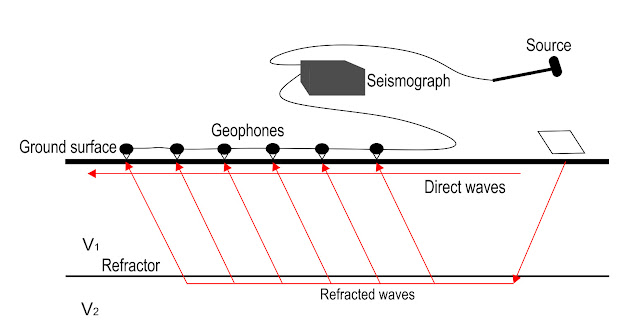Seismic refraction is useful geophysical method for investigating geological structure and rock properties.
The velocity of sound travelling through the sub-surface varies with material composition and compaction.
Seismic energy transmitted from a source at the surface will undergo refraction at boundaries between different media and eventually return to the surface.
How It Works?
The seismic energy source generates elastic waves that travel through the soil or rock from the source. According to Snell’s Law, when the seismic wave reaches the interface between two materials of different seismic velocities, the waves are refracted.When the angle of incidence equals the critical angle at the interface, the refracted wave moves along the interface between two materials, transmitting energy back to the surface.
This interface is referred to as a refractor.
Refracted seismic signal travels laterally through the higher velocity layer (refractor) and generates a ‘head-wave’ that returns to surface.
Refracted seismic signal travels laterally through the higher velocity layer (refractor) and generates a ‘head-wave’ that returns to surface.
According to Huygens’ principle the interaction of the critical refracted wave with the layer interface produces secondary waves that are transmitted as wave fronts back to the surface.
These are known as head waves.
Beyond a certain distance away from the shot, the signal that has been refracted at depth is observed as first-arrival signal in the seismograph.
Beyond a certain distance away from the shot, the signal that has been refracted at depth is observed as first-arrival signal in the seismograph.
Data Acquisition
During the acquisition, shots are deployed at the surface and the refracted waves are recorded via a linear array of sensors (geophones).The source of energy is usually located at or near each end of the geophone spread; a refraction measurement is made in each direction. These are referred to as forward and reverse measurements.
Typically, in multi-channel seismograph system, an array with 24 or 48 geophones is used.
Typically, in multi-channel seismograph system, an array with 24 or 48 geophones is used.
Types of Seismic Sources
The selection of seismic refraction energy sources is dependent upon the depth of investigation and geological conditions.Four types of energy sources are commonly used are:
1) Sledge hammers
2) Mechanical weight drop or impact devices
3) Projectile (gun) sources
4) Explosives.
Deliverables
Seismic refraction results basically presented in the form of velocity profile. There are various methods available for the processing and interpretation of refraction survey data.For example, Generalized Reciprocal Method (GRM), Plus Minus Method, Refraction Tomography and etc. Refraction tomography is a famous method since the current computer and inversion software capabilities.
In engineering, seismic velocity can be correlated to rock hardness. This is important parameter of rock lithology to predict its resistance to excavation or also known as ‘rippability’.
In engineering, seismic velocity can be correlated to rock hardness. This is important parameter of rock lithology to predict its resistance to excavation or also known as ‘rippability’.
Constraint
- The velocity of subsurface layer must increase with depth; true in most cases.
- The subsurface layers must be of sufficient thickness to be detectable.
- Data collected directly over loose soil or sediment or in the presence of excessive cultural noise may result in poor results.
- For certain places where compact clay-rich and/or shallow water overlay weak bedrock, S-wave survey (MASW) are more suitable to profile rockhead due to insufficient velocity contrast for seismic refraction survey.

.jpg)